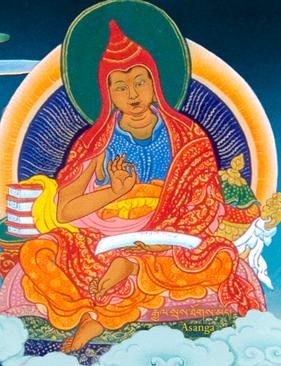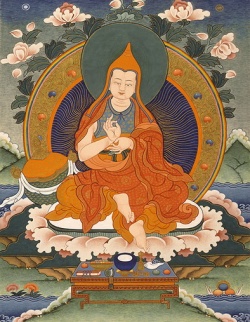Asanga
Asanga(Skt. Asaṅga, Tib. ཐོགས་མེད་, Tokmé; Wyl. thogs med) — one of the most famous Indian saints, he lived in the fourth century and was the elder brother of Vasubandhu.
He received teachings from Maitreya and transcribed them as the ‘Five Treatises of Maitreya’.
Together with Asanga's own commentaries, these texts became the basis for the philosophical schools known as Yogachara, or Chittamatra.
Asanga (fourth century) (Wu-zhuo Fa-wang): Indian Bodhisattva Dharma King who founded the Yogachara school.
One of the "seventeen great panditas."
Received the "Five Treatises of Maitreya" when he visited Maitreya in the Tusita Heaven.
Half brother of Vasubandhu
Asanga (fourth century C.E.) one of the great founders of Yogacara thought and a key Mahayana writer Asanga converted from an early school of Buddhism to MAHAYANA and eventually succeeded in persuading his younger brother, VASUBHANDU, to convert as well.
One version relates how he visited Tushita heaven and was taught the Mahayana doctrine on nonessence by MAITREYA, the Buddha of the future.
In another version he received his understanding of Mahayana from his earthly teacher, who was named Maitreya.
The two brothers founded the YOGACARA school of MAHAYANA Buddhism, which gave preeminence in its teachings to the nature of mind. Asanga wrote the Yogacarabhumi Sastra, the Mahayanasamgraha, and the Abhidharma-samuccaya.
Asanga (thogs med). Asanga was born as the son of an exceedingly learned brahmin woman who was herself the rebirth of a monk blessed by Avalokiteshvara.
Having mastered most of the scriptures of the Tripitaka, before undertaking the study of the Transcendence of Wisdom he decided to take up on actual spiritual practice.
Yet, after twelve years of meditation upon Maitreya he still had no signs of realization.
Utterly dismayed, he walked away from his cave. Soon, he came across a half-dead bitch whose lower half was infested with worms.
Great compassion arose in Asanga.
To save the bitch without killing the worms, Asanga cut a strip of his own flesh to feed the worms and closing his eyes set on removing them from the bitch's wounds with his tongue, so as to not harm them.
When, doing so, he could not reach them he opened his eyes he beheld not the bitch but Maitreya, radiant, displaying the marks and signs of a perfect Buddha.
Asanga exclaimed, "O my sole father, all those years I have been constantly meditating upon you and calling you, yet you did not come!" Maitreya spoke: "I was in your presence continually, yet because of your karmic veils you were unable to see me.
Now, through your cutting off your own flesh out of great compassion, your obscurations have been purified."
Then Maitreya took Asanga for fifty years in Tushita heaven and gave to Asanga the Mahayana teachings, following which Asanga wrote down the Five Teachings of Maitreya.
Later, having come back on earth he wrote many more treatises, performed countless miracles and converted to the Mahayana his younger brother, Vasubandhu, himself one of the greatest sages and erudite of all times.
His Writings
Further Reading
- Lobsang N. Tsonawa, Indian Buddhist Pandits from The Jewel Garland of Buddhist History, Dharamsala: Library of Tibetan Works and Archives, 1985.
- Sogyal Rinpoche, The Tibetan Book of Living and Dying, pages 125-126.
External Links
Source
Asaṅga (Sanskrit: असङ्ग; Tibetan: ཐོགས་མེད།; Wylie: Thogs med; traditional Chinese: 無著; pinyin: Wúzhuó; Romaji:
Mujaku) was a major exponent of the Yogācāra tradition in India, also called Vijñānavāda.
Traditionally, he and his half-brother Vasubandhu are regarded as the founders of this school.
The two half-brothers were also major exponents of Abhidharma teachings, which were highly technical and sophisticated hermeneutics as well.
Early Life
Asaṅga was born as the son of a Kshatriya father and Brahmin mother in Purushapura (present day Peshawar in Pakistan), which at that time was part of the ancient kingdom of Gandhāra.
Current scholarship places him in in the fourth century CE.
He was perhaps originally a member of the Mahīśāsaka school or the Mūlasarvāstivāda school but later converted to Mahāyāna.
According to some scholars, Asaṅga's frameworks for abhidharma writings retained many underlying Mahīśāsaka traits.
André Bareau writes:
- [It is] sufficiently obvious that Asaṅga had been a Mahīśāsaka when he was a young monk, and that he incorporated a large part of the doctrinal opinions proper to this school within his own work after he became a great master of the Mahāyāna, when he made up what can be considered as a new and Mahāyānist Abhidharma-piṭaka.
In the record of his journeys through the kingdoms of India, Xuanzang wrote that Asaṅga was initially a Mahīśāsaka Monk, but soon turned toward the Mahāyāna teachings. Asaṅga had a half-brother, Vasubandhu, who was a Monk from the Sarvāstivāda school.
Vasubandhu is said to have taken up Mahāyāna Buddhism after meeting with Asaṅga and one of Asaṅga's disciples.
Meditation and teachings
Asaṅga spent many years in intense Meditation, during which time tradition says that he often visited Tuṣita Heaven to receive teachings from Maitreya Bodhisattva.
Heavens such as Tuṣita Heaven are said to be accessible through Meditation, and accounts of this are given in the writings of the Indian Buddhist monk Paramārtha, who lived during the 6th century CE. Xuanzang tells a similar account of these events:
- “ In the great mango grove five or six li to the southwest of the city (Ayodhya), there is an old Monastery where Asaṅga Bodhisattva received instructions and guided the common people.
At night he went up to the place of Maitreya Bodhisattva in Tuṣita Heaven to learn the Yogācārabhūmi-śāstra, the Mahāyāna-Sūtra-alaṃkāra-śāstra, the Madhyānta-vibhāga-śāstra, etc.; in the daytime, he lectured on the marvelous principles to a great audience. ”
Asaṅga went on to write many of the key Yogācāra treatises such as the Yogācārabhūmi-śāstra, the Mahāyāna-samgraha and the Abhidharma-samuccaya as well as other works, although there are discrepancies between the Chinese and Tibetan traditions concerning which works are attributed to him and which to Maitreya.
Abhidharma Samuccaya
According to Walpola Rahula, the Thought of the Abhidharma-samuccaya is invariably closer to that of the Pali Nikayas than is that of the Theravadin Abhidhamma.
Questions of authorship
The Tibetan tradition attributes authorship of the Ratnagotravibhaga to him, while the Chinese traditions attributes it to a certain Sthiramati or Sāramati. Peter Harvey finds the Tibetan attribution less plausible.
Source
Asanga 無著 (n.d.) (Skt; Jpn Mujaku)
A scholar of the Consciousness-Only Doctrine in India who is Thought to have lived in the fourth or fifth century.
Born to a Brahman family at Purushapura in Gandhara, northern India, he contributed greatly to the systematization of the Consciousness-Only Doctrine.
Vasubandhu was his younger brother.
According to The Record of the Western Regions, Asanga became a Monk of the Mahishasaka school of Hinayana, but according to Paramartha's Biography of the Dharma Teacher Vasubandhu, he belonged to the Sarvastivada school.
In either case, he later converted to the Mahayana teachings and succeeded in persuading Vasubandhu to do the same.
The Biography of the Dharma Teacher Vasubandhu describes how Asanga, dissatisfied with the Hinayana view of nonsubstantiality, used his supernatural powers to ascend to the Tushita Heaven and there received the Mahayana Doctrine of nonsubstantiality from Bodhisattva Maitreya.
This is probably a mythicizing of his actually having studied the Doctrine under a teacher named Maitreya, a contemporary historical figure.
Asanga's works include A Collection of Mahayana Treatises, The Summary of the Mahayana, The Treatise on the Diamond Wisdom Sutra, and The Accordance with "The Treatise on the Middle Way."
Source
Asanga (also called Aryasanga), (c 300 - 370 CE) , was an exponent of the yogācāra school of Buddhist Philosophy. Traditionally, he and his half-brother Vasubandhu are regarded as the founders of this school.
Born the son of a Kshatriya father in Puruspura (Peshawar) in northernwestern India, Asanga was perhaps originally a member of the Mahīśāsaka or the Mūlasarvāstivāda school but later converted to Mahāyāna; after many years of intense Meditation, during which time some traditions say that he often visited Tushita Heaven to receive teachings from Maitreya-nātha. He went on to write many of the key Yogācāra treatises such as the Yogācārabhūmi-śāstra, the Mahāyāna-samgraha and the Abhidharma-samuccaya (refer Abhidharma) as well as other works, although there are discrepancies between the Chinese and Tibetan traditions concerning which works are attributed to him and which to Maitreya-nātha.
The Tibetan tradition attributes authorship of the Ratnagotravibhaga to him, while the Chinese traditions attributes it to a certain Sthiramati or Sāramati. Peter Harvey finds the Tibetan attribution less plausible.

